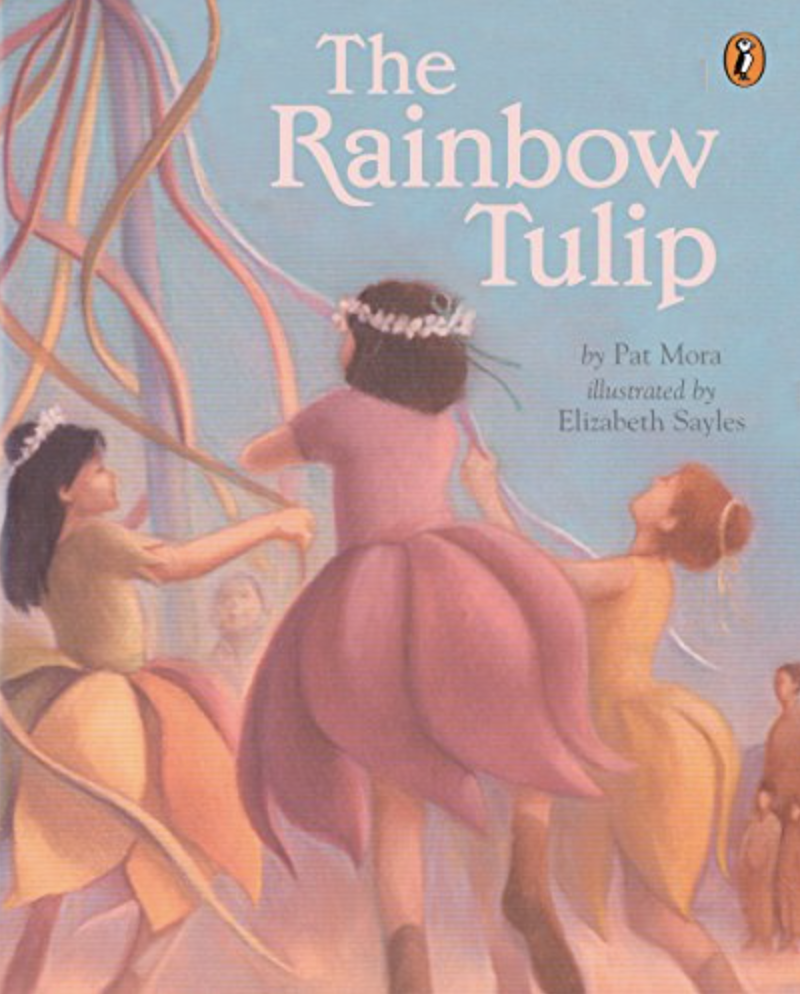The Rainbow Tulip
Book Module Navigation
Summary
The Rainbow Tulip follows a first generation Mexican-American girl. Her experiences raise issues regarding conformity, difference, and identity.
In The Rainbow Tulip, a young girl named Estelita dresses as a Rainbow Tulip for her school’s May Parade. Estelita wants to be different from the rest of the children in the Parade, but she is afraid. Estelita overcomes her fear of being different through her journey as a rainbow tulip and a first generation Mexican-American.
Read aloud video by Gradus Kinder
Guidelines for Philosophical Discussion
Pat Mora’s book, The Rainbow Tulip, prompts questions about conformity, differences, and identity. Estelita decides to dress as a Rainbow Tulip for her school’s May Parade which makes her stand out from the rest of her classmates. The Rainbow Tulip depicts the challenges and differences Estelita has in her everyday life because she has to adapt to two cultures. By participating in the May Parade, Estelita discovers that there is a way to bring both of her cultures together.
The first set of discussion questions has readers dive into the idea of conformity. In philosophy, conformity can be seen as changing one’s attitudes, beliefs, and behaviors to fit the norms of a group and become like-minded. In the book, it would have been normal for Estelita to be a yellow, pink, green, or purple tulip. Instead, she chose not to conform to the social norm and she decided to become a rainbow tulip. When should she (or anyone) choose to conform to social norms and when can she bring together her cultures without conforming to social norms?
The second set of discussion questions raises the topic of differences. Estelita is a very observant young girl. She notices that her family has many differences in comparison to the other students in her school. These can range from ethnic, national, linguistic, religious and many other differences. In Estelita’s case, her family has a different nationality, ethnicity, and language than the other students at school. Throughout the book, Estelita notices the differences in her life compared to the lives of her classmates. In her house, they converse in Spanish as compared to the other houses in the neighborhood. What makes us different from one another? Are differences good or bad?
The last set of discussion questions focuses on the idea of identity. Identity can be seen as the set of characteristics that distinguishes us from one another and that makes us unique. Unlike the other students in her class, Estelita has parents who are from Mexico. When Estelita is at home with her parents, she speaks Spanish but when she is at school with her friends, she speaks English. At home Estelita may identify herself as Mexican but at school, she may identify herself as American. Identity is an important topic as it allows students to consider the ways in which they are defined by their decisions, actions, history, family, and location. The themes of identity and conformity are interrelated since choices that affect one affect the other.
Questions for Philosophical Discussion
Conformity
- At home, her name is Estelita but at school, her name is Stella. Is it good, bad or neutral that Estelita has two names? Why or why not?
- Why would Estelita choose to be a rainbow tulip and be different from the rest of her classmates? Why wouldn’t she choose to blend in with her classmates instead? Should Estelita try to stand out or fit in? Why or why not?
- When Estelita wore the rainbow tulip costume, she had a dress that was different from everyone in her class but she wore a dress that made her happy. There has probably been a time in your life where you felt different from the rest of your classmates. Can you think of an example of when you felt this way? Is it more important to fit in or make a decision that makes you happy?
- Are there times when it is okay or good to fit in? If so, when and how?
- Are there times when it is okay or good to be different? If so, when and how?
Differences
- Is it good or bad or neither to be different?
- What makes people different from one another?
- If people are different, can they be equal? How?
- When Estelita introduces her mother to her teacher, she wishes her teacher could speak Spanish. Does Estelita’s teacher need to learn Spanish so that she can communicate with Estelita’s mother? Why or why not?
- Many students have more than one culture similar to Estelita. In what ways does Estelita show she is a part of two cultures?
- Do we have a responsibility to make our classmates with different backgrounds feel accepted?
- What should we do to make our classmates feel accepted?
Identity
- How is Estelita different from her other classmates? How is she the same?
- When Estelita notices her brother watching her, she says that she cannot let them know that she is scared. Can you think of a time when you had to act “braver” than you felt? Is it good to do this?
- When the boys in Estelita’s class notice her dress, some of them laugh at her but she doesn’t let this stop her from being the rainbow tulip. Should we change who we are based on the opinions or reactions of others? Why or why not? Does it depend on the situation?
Find tips for leading a philosophical discussion on our Resources page.







